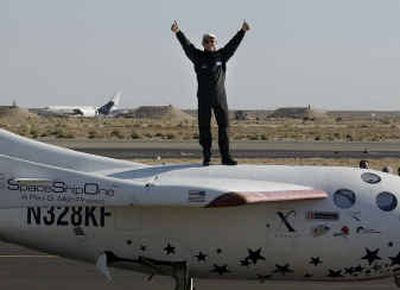Ship rockets and rolls closer to X Prize

MOJAVE, Calif. – A privately funded spacecraft appeared to rocket past its target altitude more than 60 miles above California’s high desert Wednesday morning, reaching the edges of space despite a series of unexpected rolls, and moving one step closer to winning a $10 million prize.
Minutes after its steep ascent, the commercial rocket plane, SpaceShipOne, glided to a safe landing at the Mojave Civilian Flight Test Center, a private airport where several thousand spectators gathered near the runway to watch.
Test pilot Mike Melvill, making his second solo space flight in the winged rocket plane, said he thought he probably caused the rolls by unintentionally hitting a control.
“There were no problems today. It was a near perfect flight,” Melvill told reporters after landing. “The vehicle itself worked perfectly normally.”
On the ground, the spacecraft’s builders were collecting telemetry data to confirm that they had reached their goal.
Wednesday’s flight followed Melvill’s successful June trip to the fringes of the atmosphere in the same vehicle, which was designed and built by a team led by aviation pioneer Burt Rutan.
After the flight, Rutan said he thought his team would be ready for another space flight by Sunday or Monday. If successful, that would secure the Ansari X Prize.
Shortly after the sun rose here Wednesday morning, SpaceShipOne was carried aloft beneath a wispy mother aircraft known as White Knight for an hourlong lift to the rocket plane’s launch point. White Knight released the spacecraft near 48,000 feet. After the release, SpaceShipOne’s rocket ignited for just over a minute, burning a combination of nitrous oxide (dentists’ laughing gas) and hydroxy-terminated polybutadiene (a clear rubber) to accelerate to a planned speed of Mach 3.2 (2,400 mph).
As it was ascending, the spacecraft began to roll numerous times. The rolls continued after the engine cut out.
“Did I plan the roll?” Melvill said later. “I’d like to say I did, but I didn’t. Probably I stepped on something. I was very busy.”
At that point, at a planned altitude of about 200,000 feet, the spacecraft began to coast until it reached its maximum altitude – about 340,000 feet.
Melvill was weightless in the spacecraft for about three to four minutes before beginning his unpowered descent to the commercial runway from which he departed.
SpaceShipOne was specifically designed to win the X Prize, which was conceived as an incentive for promoting space tourism. Air travel, as contest organizers are fond of pointing out, exploded in popularity after Charles Lindbergh won the $25,000 Orteig Prize for his 1927 transatlantic flight.
Earlier this week, British entrepreneur Richard Branson’s Virgin Group announced that it was licensing the SpaceShipOne technology in hopes of beginning suborbital flights for tourists by 2007. Virgin is also a sponsor of SpaceShipOne’s X Prize attempt and its company logo now appears on the rocket plane’s tail.
The Virgin deal is good news for Microsoft co-founder Paul Allen, an entrepreneur and space enthusiast whose Mojave Aerospace Ventures has spent more than $20 million funding SpaceShipOne’s development.
The spacecraft itself was built by Rutan’s Scaled Composites LLC, a Mojave-based aviation company. Rutan’s previous accomplishments include designing the Voyager, an aircraft that captured the world’s attention in 1986 when it became the first plane to circumnavigate the globe without refueling.
On June 21 Rutan sent his stubby SpaceShipOne and pilot Melvill into space for a four-minute test flight over the Mojave Civilian Flight Test Center and then got the rocket plane safely back to Earth despite serious control malfunctions.
Even with these problems corrected, however, Wednesday’s flight promised to be more difficult, because SpaceShipOne needed to carry the equivalent of three people into space to win the X Prize.